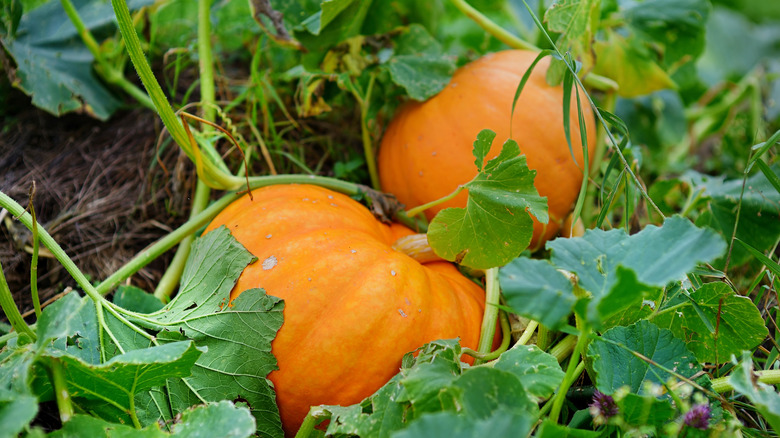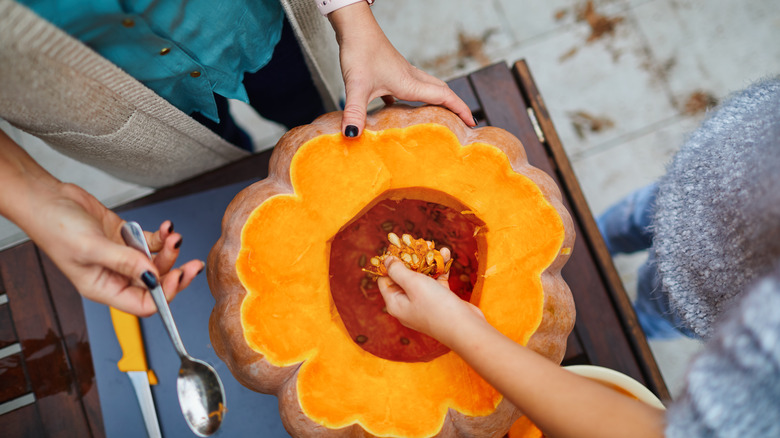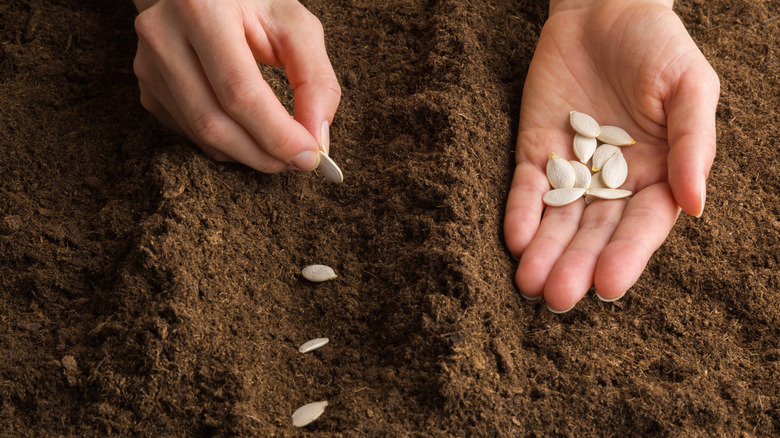The Best Way You Can Save Leftover Pumpkin Seeds To Plant Next Year
Pumpkins are an annual hallmark of the fall season and a common sight in many a home and yard come October. They are also a favorite crop for small gardens, which will usually yield gorgeously plump fruit every autumn if planted and cared for properly. If you are looking to grow your own pumpkins and don't know where to start, a perfect place to begin is with seeds you already may have inside this year's jack-o-lantern or dessert pumpkins. The seeds from this year's pumpkins can easily be saved, cultivated, and planted next year in most climates.
Pumpkin varieties range in their suitability for planting. While many sold in markets and grocery stores are hybrid crops grown for their optimal suitability for carving, these varieties tend to be less optimal for replanting. Their complex genetic makeup can be harder to reproduce in the wild, often resulting in smaller flowers and fruit at the end of the season. Heirloom pumpkin varieties, however, are perfect for the garden, and will usually produce identical results year after year.
Harvesting seeds
To harvest seeds for next year's planting, begin by carving and hollowing out your pumpkin, scooping the seeds and pulp into a bowl. Separate out the seeds and rinse in a colander under cool water until they are entirely free of pulp. While you will have your pick of many seeds to save for planting, choose the largest ones in the pile, which will usually germinate and grow the best. Use the rest for roasting, composting, or in a bird feeder.
Once they are clean, arrange the seeds in a layer on a flat baking sheet covered with wax paper, which will help prevent the seeds from sticking, allowing them to dry overnight. The next day, place the seeds on a paper towel on the sheet, which will wick any additional moisture left. Ideally, place the sheet in a cool dark place for around a month to allow any moisture to dry out, which will eliminate the risk of mold or mildew. After a month, remove any moldy or imperfect seeds before storing them in a paper envelope until spring. You can also store seeds in a plastic container in your fridge, but make sure to cut holes in the top to keep any condensation from building up inside.
Planting pumpkin seeds
Most pumpkin varieties have a growing season of around 85-120 days. The best time of year for planting pumpkins is when the ground temperature is 70 degrees with no possibility of frost. If you live in a climate with a later spring, you can also start your seeds indoors in small peat pots with 2-3 seeds per container. Before planting, assess which is the strongest seedling per pot, trim the others with scissors, and then plant in the ground. Pumpkins do best in well-draining soil with a pH of 6.5 to 6.8 that is rich in composted materials.
To maximize growth, you may want to cover your pumpkins with row cover for the first few weeks to eliminate pests and munching visitors, but remove it in early summer so the plants can be pollinated by bees. In the fall, the pumpkins will be ready for picking as soon as they have reached the deepest orange shade and the rind has hardened enough that you cannot dig in with a fingernail.


